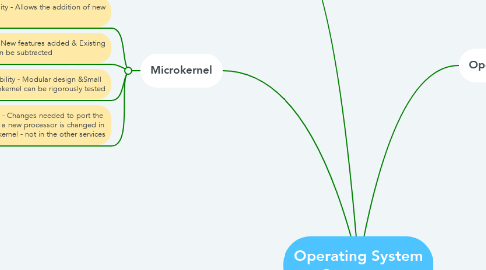
1. Layered Approach
1.1. Advantage
1.1.1. Simplicity of construction and debugging
1.2. Disadvantages
1.2.1. The careful definition and interaction of the layers
1.2.2. Less efficient
2. Microkernel
2.1. Extensibility - Allows the addition of new services
2.2. Flexibility - New features added & Existing features can be subtracted
2.3. Reliability - Modular design &Small microkernel can be rigorously tested
2.4. Portability - Changes needed to port the system to a new processor is changed in the microkernel - not in the other services
3. Operating System Design
3.1. User goals – operating system should be convenient to use, easy to learn, reliable, safe, and fast.
3.2. System goals – operating system should be easy to design, implement, and maintain, as well as flexible, reliable, error-free, and efficient.
4. Operating System Services
4.1. User interface
4.1.1. Almost all operating systems have a user interface (UI)
4.2. Program execution
4.2.1. The system must be able to load a program into memory and to run that program, end execution, either normally or abnormally
4.3. I/O operations
4.3.1. Since user programs cannot execute I/O operations directly, the operating system must provide some means to perform I/O.
4.4. File-system manipulation
4.4.1. Program capabilities to read and write files and directories, create and delete them, search them, list file Information, permission management.
4.5. Communications
4.5.1. Processes may exchange information, on the same computer or between computers over a network
4.6. Error detection
4.6.1. Ensure correct computing by detecting errors in the CPU and memory hardware, in I/O devices, or in user programs.
5. System Calls
5.1. provide the interface between a running program and the operating system.
5.2. Three general methods
5.2.1. Pass the parameters in registers.
5.2.2. Parameters stored in a block, or table, in memory, and address of block passed as a parameter in a register.
5.2.3. Parameters placed, or pushed, onto the stack by the program and popped off the stack by the operating system.
5.3. Types of System Calls
5.3.1. Process control
5.3.2. File management
5.3.3. Device management
5.3.4. Information maintenance
5.3.5. Communications
5.3.6. Protection

